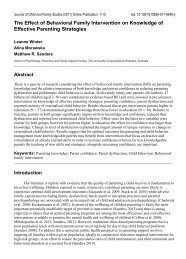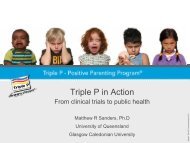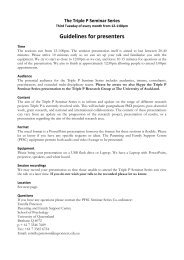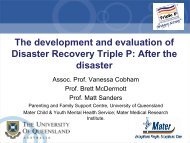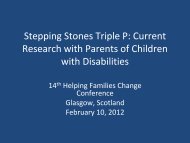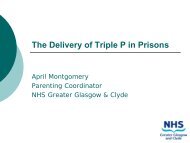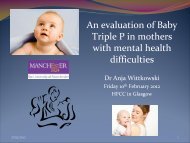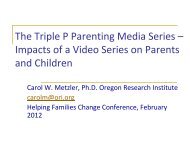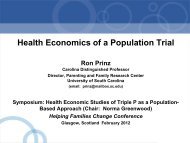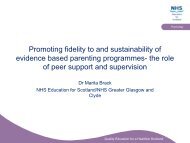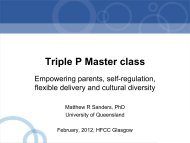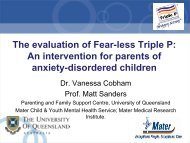Impact and acceptability of Group Triple P for - Parenting and Family ...
Impact and acceptability of Group Triple P for - Parenting and Family ...
Impact and acceptability of Group Triple P for - Parenting and Family ...
Create successful ePaper yourself
Turn your PDF publications into a flip-book with our unique Google optimized e-Paper software.
The effectiveness <strong>and</strong><br />
<strong>acceptability</strong> <strong>of</strong><br />
<strong>Group</strong> <strong>Triple</strong> P Positive<br />
<strong>Parenting</strong> Programme<br />
delivered to aboriginal<br />
parents in Canada.<br />
C.Houlding 1 , F.Schmidt 1 , S.Stern 2 , J.Jamieson 1 , & D.Borg 3<br />
1. Lakehead Universty<br />
2. University <strong>of</strong> Toronto<br />
3. Dilico Anishinabek <strong>Family</strong> Care
Acknowledgements<br />
• Leadership, staff <strong>and</strong> clients <strong>of</strong> Dilico<br />
Anishinabek <strong>Family</strong> Care.<br />
• The First Nations communities in which the<br />
research took place<br />
• Agencies within the system <strong>of</strong> local children's<br />
services.
Introduction<br />
• Aboriginal communities in Canada are at increased<br />
risk <strong>of</strong> a broad range <strong>of</strong> poor outcomes, , including<br />
high rates <strong>of</strong> unemployment, incarceration, low<br />
educational attainment <strong>and</strong> adverse health outcomes.<br />
• Of all <strong>of</strong>f-reserve aboriginal children, 40 per cent live<br />
in poverty, including subst<strong>and</strong>ard housing,<br />
overcrowding, mould.<br />
• Close to 100 First Nations communities must boil<br />
their water<br />
• Almost half <strong>of</strong> aboriginal children under 15 years old<br />
living in urban areas live with a single parent (Campaign 2000)
Context<br />
• These vulnerabilities developed in the context <strong>of</strong> cultural<br />
destruction associated with colonisation, including residential<br />
schools (Kirmayer, et al., 2000)<br />
• Residential schools; 19 th century - aggressive assimilation,<br />
<strong>for</strong>ced separation from parents <strong>and</strong> communities, active<br />
discouragement <strong>of</strong> culture.<br />
• Physical, emotional, sexual abuse, high+ mortality.
Aboriginal Children<br />
• Aboriginal children in Canada are at increased<br />
risk <strong>of</strong> a broad array <strong>of</strong> significant emotional<br />
<strong>and</strong> behavioural difficulties including suicide,<br />
substance abuse, fetal alcohol syndrome (Kirmayer,<br />
Brass, & Tait, 2000).
<strong>Parenting</strong> Programmes<br />
• Parent training has been commonly used to<br />
address some <strong>of</strong> the mechanisms leading to<br />
emotional <strong>and</strong> behavioural problems in<br />
children.<br />
• <strong>Parenting</strong> programmes based on behavioural<br />
social learning models help improve parenting<br />
<strong>and</strong> child competencies <strong>and</strong> decrease<br />
children’s s problematic behaviours (Dretzke, Davenport,<br />
Frew, Barlow, Stewart-Brown, Bayliuss, Taylor, S<strong>and</strong>ercock, & Hyde, 2009).
<strong>Triple</strong> P <strong>Parenting</strong> Programme<br />
• Improve outcomes <strong>for</strong> children <strong>and</strong> parents (deGraaf, Speetjens,<br />
Smit, deWolff, & Tavecchio, 2008a;b),<br />
• Evidence <strong>for</strong> good outcomes in other cultures<br />
including Japanese-Australian <strong>and</strong> Chinese (Leung, S<strong>and</strong>ers,<br />
Leung, Mark, & Lau, 2003; Matsumoto, S<strong>of</strong>ron<strong>of</strong>f, & S<strong>and</strong>ers, 2007), , ).<br />
• Also evidence <strong>for</strong> good outcomes in indigenous<br />
families living in Australia (Turner, et al., 2007).
<strong>Triple</strong> P Positive <strong>Parenting</strong><br />
Programme<br />
The programme is designed to encourage;<br />
• Caring relationships.<br />
• Appropriate expectations<br />
• Appropriate activities<br />
• Appropriate behaviour management strategies.<br />
• Self regulation in parents (Turner, Markie-Dadds, & S<strong>and</strong>ers, 2002).
<strong>Parenting</strong> programmes don’t<br />
always translate<br />
• Members <strong>of</strong> ethnic minorities may be less<br />
likely to attend <strong>and</strong>/or be retained in<br />
mainstream parenting programs (Biglan & Metzler, 1999)<br />
(Biglan & Metzler, 1999).<br />
• This may be due to cultural differences in<br />
perceptions <strong>of</strong> the value or relevance <strong>of</strong><br />
parenting groups.
Need to Develop Specific?<br />
• Kazdin (1993): attempting to develop <strong>and</strong><br />
evaluate interventions <strong>for</strong> every culture is<br />
unrealistically time consuming <strong>and</strong> costly.<br />
• Culture-specific interventions do not appear to<br />
yield superior outcomes to generic programs<br />
Kazdin (1993) .<br />
• Treatment as usual = no better than wait list<br />
(Weisz, Jensen-Dobson, & Hawley, 2006)
Adapting ESTs<br />
• Use ‘guiding principles’ to shape culturally<br />
sensitive adaptations <strong>of</strong> existing models <strong>of</strong><br />
intervention.<br />
• Range <strong>of</strong> adaptations : small changes to<br />
existing programs (e.g. ethnically similar<br />
actors in support materials) to large<br />
(interventions developed specifically <strong>for</strong> a<br />
particular cultural group) (Kazdin, 2000).
Indigenous Australian <strong>Triple</strong> P<br />
• Developed with extensive consultation (Turner, Richards, &<br />
S<strong>and</strong>ers, 2007).<br />
• Similar content to regular <strong>Triple</strong> P.<br />
• Changes to resources, images <strong>and</strong> materials<br />
(simplified text; use <strong>of</strong> actors <strong>and</strong> scenarios)
In this context...<br />
Dilico Anishinabek <strong>Family</strong> Care...<br />
• Thunder Bay <strong>and</strong> 13 First Nations<br />
communities<br />
• Mid 2000s parenting identified as a priority.<br />
• Leadership attended a children’s s mental health<br />
conference.<br />
• Consulted with B<strong>and</strong> Councils<br />
• Decided to adopt <strong>Triple</strong> P.
Process <strong>of</strong> Research<br />
• Dilico Anishinabek approached Lakehead<br />
University to collaborate in a <strong>for</strong>mal<br />
evaluation <strong>of</strong> use <strong>of</strong> <strong>Triple</strong> P.<br />
• Permission from B<strong>and</strong> Councils.
Research Design Considerations<br />
• Qualitative research methods have been used<br />
in examination <strong>of</strong> evidence based parenting<br />
interventions (Stern, Alaggia, Watson, & Morton, 2008)<br />
• Qualitative methods may be more consistent<br />
with cultural values <strong>of</strong> aboriginal Canadians<br />
than use <strong>of</strong> st<strong>and</strong>ardised instruments (Silverstein & Auerbach,<br />
2009).<br />
• Qualitative research generates rich accounts <strong>of</strong><br />
participants’ experience; insight that might be<br />
lost if only quantitative analysis were<br />
considered (Creswell, 2007).
Research Questions<br />
Was participation in <strong>Group</strong> <strong>Triple</strong> P helpful?<br />
Were there changes in parenting <strong>and</strong> child behaviour in aboriginal<br />
parents in Canada following participation in <strong>Group</strong> <strong>Triple</strong> P?<br />
Was <strong>Group</strong> <strong>Triple</strong> P consistent with the values <strong>of</strong> aboriginal parents?
METHOD
Participants<br />
• All participants were from one city <strong>and</strong> two towns in<br />
northwestern Ontario, Canada.
Life in Northern Towns
Parents<br />
Participants..<br />
• Eleven parents, 10 mothers<br />
• Parents <strong>of</strong> 3-123<br />
yr olds.<br />
• 100% parents self-identified as aboriginal Canadian.<br />
• Not m<strong>and</strong>ated attendance.<br />
• Parent participants had completed <strong>Group</strong> <strong>Triple</strong> P parenting<br />
programme.<br />
Facilitators<br />
• Eight group facilitators, working at an aboriginal mental<br />
health agency.<br />
• 50% <strong>of</strong> facilitators self-identified as aboriginal Canadian.<br />
• Accredited <strong>Triple</strong> P facilitators.
Procedure<br />
Facilitators;<br />
- Presented research plan<br />
- Managers not told who decided to participate.<br />
Parents;<br />
- Clinicians initially approached.<br />
- Researcher followed up with interested.<br />
- Clinicians not told whether parent ultimately<br />
decided to participate.<br />
- $20 voucher; community meal.
Ethical considerations<br />
• Voluntary<br />
• Anonymous<br />
• Transcription in another city.<br />
• Transcripts reviewed by first <strong>and</strong> second<br />
authors (i.e. not employed by or members <strong>of</strong><br />
the participating organization).<br />
• Cultural – CIHR guidelines (e.g. permission<br />
from B<strong>and</strong> Councils be<strong>for</strong>e starting research;<br />
questionnaires; capacity building).
Interview Questions<br />
Helpfulness<br />
• How was <strong>Group</strong> <strong>Triple</strong> P helpful?<br />
• Where there ways in which it was not?<br />
Cultural Appropriateness<br />
• How was the <strong>Triple</strong> P group consistent with your<br />
values? Or not?<br />
• What strategies did you agree with? Were there<br />
any that you didn't you agree with?
Feedback<br />
• The interviews were recorded, transcribed, <strong>and</strong><br />
the data were then analyzed.<br />
• An initial summary was given to facilitator<br />
participants (‘member(<br />
checking’).<br />
• This was made available to parent participants.<br />
• Changes to interpretation <strong>of</strong> data were made<br />
according to feedback given (Creswell, 2007).
Process in <strong>Triple</strong> P<br />
• Guided discussion,<br />
• DVDs,<br />
• Workbooks,<br />
• Role plays.<br />
• Based on a ‘self-regulation’.
Intervention in Clinical Practice<br />
• Designed : 8 sessions: 6 group + two follow up<br />
at home (Turner, Markie-Dadds, & S<strong>and</strong>ers, 2002).<br />
• Two sites: 7 sessions; 5 group + 2 home visits<br />
or phonecalls.<br />
• One site: 3 long sessions on consecutive days,<br />
+ 2 home visits.
Intervention in Clinical Practice<br />
• Some sites used incentives <strong>for</strong> attendance at<br />
parenting sessions.<br />
• One site: gift bags<br />
• One site: children’s s seasonal clothing <strong>for</strong> full<br />
attendance. The B<strong>and</strong> Council <strong>of</strong> the First Nation<br />
paid <strong>for</strong> these incentives.
Intervention in Clinical Practice<br />
• The regular DVDs <strong>and</strong> workbooks were used<br />
<strong>for</strong> earlier groups.<br />
• Indigenous workbooks <strong>and</strong> DVDs were used<br />
<strong>for</strong> later groups (when these resources became<br />
available).<br />
• Some parents were given a choice <strong>of</strong> the<br />
DVDs they would prefer to use.
Intervention in Clinical Practice<br />
• Parents were not differentiated according to<br />
the resources used within <strong>Group</strong> <strong>Triple</strong> P.<br />
• Only the DVDs <strong>and</strong> workbooks were different.<br />
Other content <strong>and</strong> process <strong>of</strong> the program they<br />
received was essentially the same.<br />
• Participants were specifically asked about the<br />
usefulness <strong>of</strong> the DVDs <strong>and</strong> workbooks within<br />
interviews.
Intervention integrity<br />
• All facilitators had completed training <strong>and</strong><br />
attained competency-based accreditation in<br />
<strong>Group</strong> <strong>Triple</strong> P.<br />
• Facilitators received supervision from<br />
managers committed to implementing the<br />
program with fidelity to its design.<br />
• Facilitators had run between two <strong>and</strong> ten<br />
<strong>Group</strong> <strong>Triple</strong> P groups.
Analysis<br />
Phenomenological Descriptive Analysis (Collaizzi, 1978)<br />
- Interview transcribed<br />
- Transcripts read several times<br />
- Coded <strong>for</strong> key themes/ phrases related to research<br />
questions.<br />
- Meanings<br />
- Themes synthesised.<br />
- Summarised in ‘exhaustive description’.
Credibility<br />
Transferability<br />
Is this a credible interpretation<br />
<strong>of</strong> the data?<br />
Believable from the<br />
perspective <strong>of</strong> the participant<br />
in the research?<br />
Will this apply or transfer<br />
elsewhere?<br />
Trustworthiness<br />
• Bracketing<br />
• Peer debriefing<br />
• Data saturation<br />
• Formal <strong>and</strong> in<strong>for</strong>mal ’member checking ‘ (asking<br />
participants whether interpretation is consistent with<br />
their experience)<br />
• Description <strong>of</strong> participants, communities.<br />
Dependability<br />
Assessment <strong>of</strong> the quality <strong>of</strong><br />
the integrated process <strong>of</strong> data<br />
collection, data analysis,<br />
meaning summaries.<br />
• Process <strong>of</strong> reviewing, coding, synthesizing<br />
transcripts.<br />
• Two researchers reviewing independently,<br />
synthesised.<br />
Confirmability<br />
How well the findings are<br />
supported by the data<br />
collected?<br />
Degree to which the results<br />
could be confirmed or<br />
corroborated by others.<br />
• Audit trail: including field <strong>and</strong> reflexive notes (Lincoln<br />
& Guba, 1985), data reduction products <strong>and</strong> raw<br />
data.
RESULTS
Results: Was it Helpful?<br />
Generally very positive;<br />
The reserve is a small community <strong>and</strong> we don’t<br />
need a newspaper… the parents will tell you<br />
whether it’s s good or not.. They tell each other <strong>and</strong><br />
then it’s s like ‘they told me about this program <strong>and</strong><br />
I want to try.’
Results: Was it Helpful?<br />
Seemed to compare well to other programmes;<br />
…Nothing could come close to this parenting<br />
program… it’s s not the answer to everything. Its<br />
not going to fix everything, but it’s s a start <strong>and</strong> I<br />
really enjoy running it.
Results: Was it Helpful?<br />
Further, these results were noticed by other<br />
agencies including from schools <strong>and</strong><br />
childcares;<br />
I get feedback from the daycares or the schools on<br />
‘wow, what’s s happened to him or her?’
Results: Was it Helpful?<br />
Changes in the family’s s overall mental<br />
health <strong>and</strong> functioning;<br />
I see less stress <strong>for</strong> the parent, I see the parent becoming hopeful that<br />
they found something that seems to have proven effective. They’re<br />
reporting that the children are more cooperative <strong>and</strong> ... the family seem<br />
to be happier on a daily basis ... I get reports that they’re absolutely<br />
amazed, they’re applying a technique <strong>and</strong> following through with that<br />
creates change in such a short time.
Results: Was it helpful?<br />
The program might be considered helpful<br />
because it encouraged a sense <strong>of</strong> optimism;<br />
I have been [working with parents] <strong>for</strong> twenty years <strong>and</strong><br />
the greatest gift I can give a client is … validation that<br />
they have capacity to do something <strong>and</strong> that I’m I m there to<br />
support them <strong>and</strong> that sense <strong>of</strong> hope <strong>for</strong> change. And I<br />
think ... the <strong>Triple</strong> P literature <strong>and</strong> the videos do that…
Use <strong>of</strong> Incentives<br />
While incentives were used to encourage<br />
attendance in some groups, the programme<br />
was still perceived as helpful;<br />
They may not be there <strong>for</strong> parenting. They may<br />
just be there to get their children’s s spring or<br />
summer clothes… but whatever gets them there,<br />
they get the in<strong>for</strong>mation. Then they’ll run with it…
How <strong>Parenting</strong> Changed<br />
In promoting responsive relationships…<br />
… so I just kind <strong>of</strong> learned to drop the dish tray or<br />
leave the laundry basket piled up.. And.. Just sit<br />
<strong>and</strong> listen to him, what he wants to tell me.
How <strong>Parenting</strong> Changed<br />
Being more positive;<br />
I think it really did good <strong>for</strong> me because instead <strong>of</strong><br />
me lashing <strong>and</strong> yelling all the time... it was more<br />
helpful <strong>for</strong> me to ... actually walk up to him <strong>and</strong><br />
just say talk calmly to him without raising my<br />
voice…<br />
I’ve started complimenting [my daughter]…she<br />
just goes shocked ... then she just is kind <strong>of</strong> shy<br />
because she didn’t t know what to do about it ... I<br />
could see… that she was, like, happy with herself
How <strong>Parenting</strong> Changed (cont.)<br />
Introducing new strategies <strong>for</strong> discipline;<br />
…I I did come through circumstances ... you know, like<br />
elders yelling at me ... So, yeah, I thought … ‘okay,<br />
yeah I have to use my calm voice’ … I just have to<br />
keep reminding myself, ‘okay, I have to like stay<br />
calm take a breath.’<br />
... the only way my mum knew how – <strong>and</strong> she taught<br />
me – is to hit ... after doing wrong. So this is how I<br />
brought up my kids… now there’s s new ways <strong>of</strong><br />
disciplining your child so, so I’m I m happy <strong>for</strong> that … it<br />
seems like the cycle is broken now…
How <strong>Parenting</strong> Changed (cont.)<br />
Parents mentioned that they were attempting to<br />
improve their consistency across caregivers:<br />
Now we [my ex-husb<strong>and</strong> <strong>and</strong> I] are<br />
communicating more when it comes to the<br />
behavior <strong>and</strong> discipline <strong>of</strong> [our child]... after<br />
taking the <strong>Triple</strong> P... I went to him... ‘we<br />
need to be on the same page'.
How <strong>Parenting</strong> Changed (cont.)<br />
Some parents talked about the helpfulness <strong>and</strong><br />
impact <strong>of</strong> a routine, as a strategy that helped to<br />
bring appropriate structure to the child's<br />
activities:<br />
I made... a schedule ... with the charts ... coming home<br />
after school, doing their homework then they get to play<br />
out ... I follow through with it, having a schedule <strong>for</strong><br />
them to do ... instead <strong>of</strong> it being all over. And they’ve<br />
got a certain bed time… because I learned that it’s s better<br />
<strong>for</strong> the kids to have at least eleven to twelve hours sleep<br />
a night.
How Children Changed<br />
Some participants reported that children’s s competencies<br />
<strong>and</strong> behaviour improved;<br />
… it really does work. I’m I m really surprised because my kids<br />
were going <strong>of</strong>f the walls once in a while <strong>and</strong> ... it really<br />
calmed them down <strong>and</strong> they really started to listen…<br />
... I feel like we’ve grown a lot closer. I feel like she herself is<br />
stronger as a child, too. I feel like <strong>Triple</strong> P has made me feel<br />
better as a mother <strong>and</strong> I feel like that it made my daughter<br />
stronger <strong>and</strong> confident <strong>and</strong>… more open.
Fit with Parents’ Values<br />
Participants perceived that the strategies <strong>and</strong><br />
values on which they were based were<br />
consistent with parents’ values;<br />
With all the families I have worked with, none <strong>of</strong><br />
them have said that ‘you know none <strong>of</strong> this really<br />
fit <strong>for</strong> me’ or ‘I I don’t t believe in this’. . If anything,<br />
they are like ‘I I do a lot <strong>of</strong> these’.
Fit with Parents’ Values<br />
There was a sense that the strategies were<br />
experienced as part <strong>of</strong> parents’ values, not<br />
<strong>for</strong>eign to them;<br />
… It didn’t t come from our culture, you know my Mum, my<br />
Mum <strong>and</strong> them be<strong>for</strong>e they went to the boarding school. There<br />
was no such thing as ... hitting there was a gentle way <strong>of</strong><br />
disciplining, but when they went to the boarding school that’s<br />
where they learnt to hit their kids... so now what they’re<br />
teaching us is the parenting .. to go back to where, … it was<br />
be<strong>for</strong>e, the way it’s s supposed to be ...
Fit with Parents’ Learning Styles<br />
And the material was presented in a manner<br />
that parents found compelling;<br />
…The role play in the delivery <strong>of</strong> the program… is<br />
the style that an aboriginal person would want to<br />
learn, as opposed to a lecture style.<br />
… we are visual learners. We need to see things <strong>and</strong><br />
to be taught <strong>and</strong> get involved.. Practicing.. Helps<br />
them learn <strong>and</strong> they really enjoyed it.
Indigenous Resources<br />
• Indigenous workbooks were consistently<br />
perceived as an improvement on the regular<br />
workbooks.<br />
• Indigenous DVDs – a more mixed response.
How Could it be Improved?<br />
• A number <strong>of</strong> participants suggested<br />
incorporating images <strong>and</strong> scenarios in the<br />
DVDs that are consistent with experience <strong>of</strong><br />
aboriginal families;<br />
… It will be nice to see them do [the DVD] on a<br />
reserve.. Because the reserve is like a whole<br />
family… because you have your cousin who lives<br />
next door.. And they help you, so everyone is<br />
involved <strong>and</strong> not just your household.
How Could it be Improved?<br />
Involve extended families in training;<br />
It would have been good <strong>for</strong> the gr<strong>and</strong>parent,<br />
even the aunties <strong>and</strong> uncles.. Because.. my<br />
kids spend a lot <strong>of</strong> time at their granny’s<br />
house.. or extended family..
Limitations <strong>of</strong> <strong>Triple</strong> P<br />
<strong>Triple</strong> P may be less effective in families with<br />
complex problems;<br />
…So here you are … you go to someone’s s house <strong>and</strong> it’s<br />
‘okay we’re going to do this on <strong>Triple</strong> P today’. . Then you<br />
walk in the door <strong>and</strong> someone’s s got their teeth knocked out<br />
… or there’s s no food in the house because something else<br />
happened. Or there’s s crisis <strong>and</strong> you want to be moving<br />
<strong>for</strong>ward <strong>and</strong> <strong>Triple</strong> P <strong>and</strong> ‘this is my agenda’. . It’s s not their<br />
agenda. Their agenda is survival. So <strong>Triple</strong> P would work<br />
best when the family is pretty stable. They want things to<br />
change.
Discussion<br />
• <strong>Group</strong> <strong>Triple</strong> P can be beneficial even in the<br />
context <strong>of</strong> the grave adversity experienced by<br />
aboriginal people in Canada.<br />
• <strong>Group</strong> <strong>Triple</strong> P was helpful at introducing new<br />
ideas <strong>and</strong> refining skills in a compelling<br />
manner.<br />
• Improvements in parenting <strong>and</strong> child<br />
behaviours were reported.
Discussion: Values<br />
• Consistent with values (c.f. Seven Teachings<br />
<strong>of</strong> the Anishnabek e.g. shunning; giving honor)<br />
(Dionne, Davis, Sheeber, & Madrigal, 2009).<br />
• Strategies might be more consistent than some<br />
frequently used parenting practices that<br />
emerged as a result <strong>of</strong> their experiences with<br />
European colonizers.
Discussion: Values<br />
• Way in which strategies taught also consistent<br />
• Many <strong>of</strong> the participants had experiences with<br />
numbers <strong>of</strong> other parenting programmes.<br />
• Many considered <strong>Triple</strong> P better <strong>and</strong> exceeded<br />
expectations.<br />
• This might be because ‘h<strong>and</strong>s-on’; ‘here <strong>and</strong><br />
now’, , rather than focused on feelings/ history/<br />
insight.
Strengths <strong>of</strong> the Study<br />
• Unique: examination <strong>of</strong> helpfulness <strong>of</strong> <strong>Group</strong><br />
<strong>Triple</strong> P with aboriginal parents in Canada.<br />
• There<strong>for</strong>e, results provide actual data to in<strong>for</strong>m<br />
decisions about investment in training <strong>and</strong><br />
programmes.<br />
• Qualitative design: depth <strong>of</strong> underst<strong>and</strong>ing,<br />
participants’ experiences in their own words.<br />
• Would not have been captured with a quantitative<br />
design.
Limitations <strong>of</strong> Study<br />
• Retrospective.<br />
• Quasi experimental<br />
• Completers, volunteers.<br />
• Limited number <strong>of</strong> sites (e.g. health <strong>of</strong><br />
communities as moderators <strong>of</strong> outcomes).<br />
• Heterogeneity in how it was delivered.<br />
• Heterogeneity in resources used.
Implications<br />
• Worth continuing to invest in research<br />
evaluating the program<br />
• Worth investing in enhancing effectiveness<br />
For example, through;<br />
• funding substantial incentives <strong>for</strong> attendance,<br />
• broadening training to include teens <strong>and</strong> <strong>for</strong><br />
children with special needs, <strong>and</strong><br />
• developing strategies to improve the impact <strong>for</strong><br />
more complex or dysfunctional families.<br />
• In<strong>for</strong>mative process ‘give us the in<strong>for</strong>mation’
Future Directions<br />
• Investigate: acculturation,<br />
isolation, problem severity <strong>and</strong><br />
complexity, health <strong>of</strong> host<br />
community as moderators <strong>of</strong><br />
outcome.<br />
• Develop aboriginal Canadian<br />
<strong>Triple</strong> P. Incorporate actors;<br />
scenarios; images; metaphor/<br />
stories relevant to aboriginal<br />
families in Canada.<br />
• Public health model <strong>of</strong><br />
intervention (S<strong>and</strong>ers, 2010).
Thank You!



